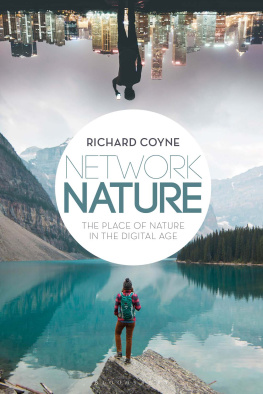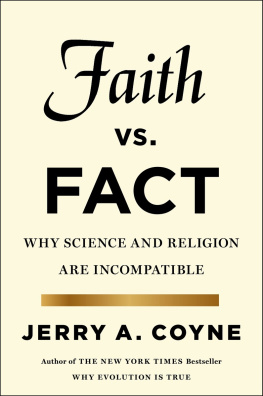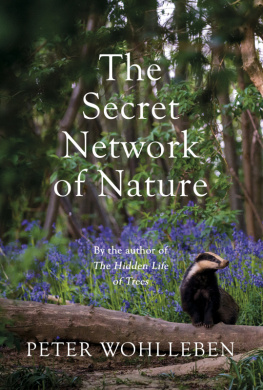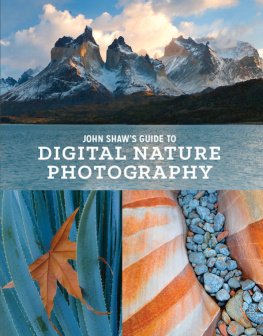Coyne - Network nature: the place of nature in the digital age
Here you can read online Coyne - Network nature: the place of nature in the digital age full text of the book (entire story) in english for free. Download pdf and epub, get meaning, cover and reviews about this ebook. City: London;New York;Oxford;New Delhi;Sydney, year: 2018, publisher: Bloomsbury UK;Bloomsbury Academic, genre: Romance novel. Description of the work, (preface) as well as reviews are available. Best literature library LitArk.com created for fans of good reading and offers a wide selection of genres:
Romance novel
Science fiction
Adventure
Detective
Science
History
Home and family
Prose
Art
Politics
Computer
Non-fiction
Religion
Business
Children
Humor
Choose a favorite category and find really read worthwhile books. Enjoy immersion in the world of imagination, feel the emotions of the characters or learn something new for yourself, make an fascinating discovery.
- Book:Network nature: the place of nature in the digital age
- Author:
- Publisher:Bloomsbury UK;Bloomsbury Academic
- Genre:
- Year:2018
- City:London;New York;Oxford;New Delhi;Sydney
- Rating:4 / 5
- Favourites:Add to favourites
- Your mark:
- 80
- 1
- 2
- 3
- 4
- 5
Network nature: the place of nature in the digital age: summary, description and annotation
We offer to read an annotation, description, summary or preface (depends on what the author of the book "Network nature: the place of nature in the digital age" wrote himself). If you haven't found the necessary information about the book — write in the comments, we will try to find it.
Coyne: author's other books
Who wrote Network nature: the place of nature in the digital age? Find out the surname, the name of the author of the book and a list of all author's works by series.
Network nature: the place of nature in the digital age — read online for free the complete book (whole text) full work
Below is the text of the book, divided by pages. System saving the place of the last page read, allows you to conveniently read the book "Network nature: the place of nature in the digital age" online for free, without having to search again every time where you left off. Put a bookmark, and you can go to the page where you finished reading at any time.
Font size:
Interval:
Bookmark:

NETWORK NATURE
NETWORK NATURE
THE PLACE OF NATURE IN THE DIGITAL AGE
Richard Coyne

To Chris
CONTENTS
Natural
selection
Numinous
nature
Nature is on the side of the independent, the hopeful, the free, the good and the healthy. Who does not hanker after places and things that are unmediated, authentic and natural ? But some digital-device users think that their technologies get in the way of direct access to nature. It is as if relentless connectivity, accompanied by work stress, boredom and poor health, burdens urban dwellers who must now look to nature to deliver the opposites of this technological affliction. It is easy to succumb to the view that nature is what is left in the crucible of human experience purged of troublesome technology and artifice.
But technology provides obvious benefits. Techno-science monitors, records and predicts the state of the natural world, from weather to life beneath the Arctic, and to great effect. Now you cannot make buildings of any scale without digitally enhanced surveys of sites, terrains, local bio-ecologies and climatic conditions. Data permeates designers interactions with nature. Designers, advisors, critics and developers see nature increasingly through the lens of data, and define nature in its terms.
I have two targets in my sights. The first target is the easy binary that puts technology at odds with nature; second is the trust and power accorded to data. Yes, we can be suspicious of digital technologies, but not because of the myriad changes in practices they require of us. Nor because they encourage brain overload, diminish authentic social interaction or distance us from nature. The problem is not devices but data, and the way it filters our perceptions of the world. Occluded by data, it is as if the nature we seek becomes even more elusive and limited. Data is amenable to mechanical manipulation, and there is a lot of it. So, it is easy to see data as a conduit to the unmediated experience of nature. For big-data enthusiasts, data subsumes nature.
I want to unseat the priority of a data-oriented frame. I challenge the importance accorded to data in design, and affirm instead its subservience to the rich field of semiotics. Signs, signals and symptoms, and their interpretation, permeate the whole that is nature. Designers, practitioners and consumers can usefully connect to the communicative networks of natural systems. Semiotics contributes much-needed debate about digital technologies and their design, as architects, landscape architects, planners and engineers respond to the challenges affecting landscapes, urban environments and nature. Nature communicates through signs; signs are ubiquitous in nature. But signs are not data. Nor is nature just data. I think that putting data in its place provides a more rounded and rich cultural orientation to the naturetechnology relationship. Semiotics also helps us understand nature and health. At least, semiotics and health trade in a common language of signs and symptoms.
Semiotics also provides a means of reintroducing meaning into a world view saturated with data. Environmentalist Bill McKibben wrote The End of Nature , the first edition of which appeared in 1989.
He advances a couple of poignant illustrations of this semiotic shift. The first draws on our aversion to things that we know will end before their time:
McKibben claims he chose not to know too much about vegetative die back, and other problems within the natural world affected by humans: I like the woods best in winter when it is harder to tell what might be dying.
The natural environment appears vulnerable across many dimensions, not the least its meanings. If we have learnt anything from politicians skilled at manipulating and trading in public opinion, it is that words and meanings really do matter, as does truth. Signs are crucial in understanding the environment and the complex discourses it entails. Semiotics supports this challenge. The stakes have never been higher, considering the threats we face, and how much we depend on what we think of as the natural environment.
I am grateful for insights into the disciplines of Landscape Architecture, Architecture and environment from colleagues Peter Aspinall, Dennis Dollens, Hannah Drummond, Roxana Bakhshayesh Karam, Michelle Bastian, Rebecca Crowther, Fabrizio Gesuelli, Philip Goulding, Matluba Khan, Dorothea Kalogianni, Asad Khan, Sophia Lycouris, Angus Macdonald, Patricia Macdonald, Panos Mavros, Stella Mygdali, Cristina Nan, Christopher Neale, Dimitra Ntzani, Tolulope Onabolu, Miguel Paredes Maldonado, Andrew Patrizio, Agnes Patuano, Jenny Roe, Graham Shawcross, Katerina Talianni, Neil Thin, Tiago Torres Campos, Catharine Ward Thompson and Dave Wood. Some of the work I reference here draws on the collaborative project Mobility, Mood and Place (EP/K037404/1), supported through the EPSRC/AHRC/SRC/MRC scheme Design for well-being: Ageing and mobility in the built environment, which has as its focus well-being and outdoor environments. I am also indebted to the enthusiasm of students in the MSc in Design and Digital Media and the MSc by Research in Digital Media and Culture, as well as teaching colleagues in the Edinburgh School of Architecture and Landscape Architecture in the University of Edinburgh.
Figure 1.1 Radio tuning dial. 1940s Philips 206a Bakelite Art Deco
valve table radio
Figure 1.2 An exercise in attention: the bear in the park. Meadows Walk
Edinburgh
Figure 2.1 Technology revealing isolated nature. Weather station
Blea Lake, Fgra Mountains, in central Romania
Figure 2.2 Illustration of Protozoa from Raoul Heinrich Francs book
Die Pflanze als Erfinder (1920)
Figure 2.3 Charles Jenckss Landform. Scottish National Gallery of
Modern Art, Edinburgh
Figure 3.1 Search results from Google Images. The top image
(Crieff, Scotland) is by the author. Those beneath are matches
found by Google Images search
Figure 3.3 Overlay of signs in the countryside. Pennine Way, Derbyshire,
England
Figure 4.1 Books containing the human gene sequence at the
Wellcome Trust, London
Figure 5.1 The discovery of fire. Illustration by Cesare Cesariano
(14751543) to Vitruviuss Ten Books of Architecture
Figure 5.2 Deep window reveal emphasizes the relationship between
inside and outside. Lyme Park, Disley, Stockport, England
Figure 5.3 Organically formed media facade as a proto-digital skin,
Graz Kunsthaus, architects Peter Cook and Colin Fournier (2003)
Figure 5.4 Bioreceptive Calcareous Composite Wall by Zhili Wang,
Xinhe Lin, Yuxin Jiang, and Qingyue Zeng at the BiotA Lab,
Bartlett UCL (Prof. Marcos Cruz and Richard Beckett). This is a multilayered cast of a bioreceptive prototype with use of
different particle sizes to enhance a selective water-retention
system in a wall
Figure 6.1 Master Rock site-specific performance 15 October 2015.
Courtesy of Artangel and Maria Fusco
Figure 6.2 The golden spike marking the Global Boundary Stratotype
Section and Point (GBSSP) at the base of the Ediacaran
Period 16 August 2008
Figure 6.3 Landscape fractured by underground forces, residence of
Loki the trickster god. Rangaring ytra, Suurland, Iceland
Figure 7.1 Synthetic landscape in computer game by Daoliangzi Zhang.
MSc Design and Digital Media (supervised by Jules Rawlinson)
used with permission
Figure 7.2 Raticate, an augmented reality Pokmon Go character
appearing on a busy road
Font size:
Interval:
Bookmark:
Similar books «Network nature: the place of nature in the digital age»
Look at similar books to Network nature: the place of nature in the digital age. We have selected literature similar in name and meaning in the hope of providing readers with more options to find new, interesting, not yet read works.
Discussion, reviews of the book Network nature: the place of nature in the digital age and just readers' own opinions. Leave your comments, write what you think about the work, its meaning or the main characters. Specify what exactly you liked and what you didn't like, and why you think so.









